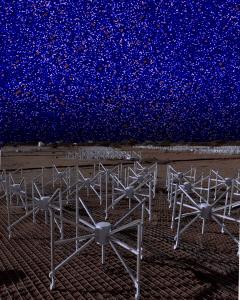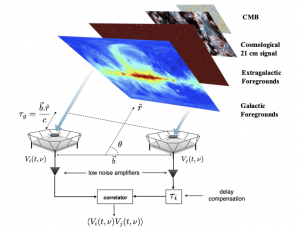Ancient Universe 'warmed up' before it 'lit up', ICRAR researchers find

The image of the radio sky (background) is the 'cleanest' signal ever produced using data from the Murchison Widefield Array (foreground). Credit Nunhokee et al/ICRAR/Curtin University
ICRAR astronomers find early Universe was warm before stars formed, ruling out a cold start to cosmic dawn using decade-long MWA radio data
PERTH, WESTERN AUSTRALIA, AUSTRALIA, September 30, 2025 /EINPresswire.com/ -- Astronomers hunting for evidence of the light from the first stars and galaxies have found that the Universe was warm, rather than cold, before it “lit up”.
The Curtin University-led team from the International Centre of Radio Astronomy Research (ICRAR) was searching for the elusive 'Epoch of Reionisation', using the Murchison Widefield Array telescope (MWA) located at Inyarrimanha Ilgari Bundara, the CSIRO Murchison Radio-Astronomy Observatory on Wajarri Yamaji Country in Western Australia.
"Our research was conducted over two phases. During the initial research, we obtained our first evidence of gas heating up between galaxies nearly 800 million years after the Big Bang," said ICRAR first phase lead author, Dr Ridhima Nunhokee
The Epoch of Reionisation is a period early in the Universe's history that is predicted by theory but is yet to be detected using radio telescopes. It signifies the end of the Cosmic Dark Ages, roughly a billion years after the Big Bang, when the gas between galaxies shifted from opaque to transparent, allowing light from the first stars and galaxies to travel throughout the Universe.
Dr Nunhokee explained that to study this early period of the Universe, astronomers must isolate the faint signal from the Epoch of Reionisation, identify and remove every other source of radio waves in the Universe from their observations.
“These include emissions from nearby stars and galaxies, interference from the Earth's atmosphere, and even noise generated by telescope itself. Only after carefully subtracting these ‘foreground signals’ will the remaining data reveal signals from the Epoch of Reionisation,” Dr Nunhokee said.
"From this research, we have developed methods to deal with the foreground contamination, and subtract the signals we don't want, but also better understand our telescope and come up with a clean signal.
"We've also been able to integrate about ten years of MWA data together, to observe the sky for longer than we ever have before. That's the other reason we've come closer than ever to detecting the signal."
The quality and quantity of this new dataset are what made this discovery possible, according to the team. A cold Universe would have produced a signal that would have been visible due to the MWA’s extensive capabilities. The lack of that signal rules out such a 'cold start' to reionisation and means the Universe must have been 'pre-heated' before reionisation happened.
Professor Cathryn Trott, who leads the Epoch of Reionisation project at ICRAR, was the lead author of the second phase of the research.
"As the Universe evolved, the gas between galaxies expands and cools, so we would expect it to be very, very cold," says Professor Trott.
"Our measurements show that it is at least heated by a certain amount. Not by a lot, but it tells us that very cold reionisation is ruled out. That's really interesting.
“The research suggests this heating is likely driven by the energy from early sources of X-rays from early black holes and stellar remnants spreading through the Universe.”
The lessons learned from processing these data will jump-start the search for the Epoch of Reionisation with the SKA telescopes, currently under construction on Wajarri Country in Western Australia and the Northern Cape of South Africa.
"All these existing techniques will help us find what's missing," said Dr Nunhokee.
"The signal is definitely buried in there. It's just improving on our data, and getting more data, cleaner data, to reach it."
The initial paper “Limits on the 21cm power spectrum from MWA observations” was published in The Astrophysical Journal on August 8th 2025.
The second phase paper, “Improved limits with the MWA using Gaussian information”, was published overnight in The Astrophysical Journal.
Charlene D'Monte
International Centre for Radio Astronomy Research
+61 468 579 311
communications@icrar.org
Dr Ridhima Nunhokee: Closing in on the Epoch of Reinonisation. Credit: ICRAR
Legal Disclaimer:
EIN Presswire provides this news content "as is" without warranty of any kind. We do not accept any responsibility or liability for the accuracy, content, images, videos, licenses, completeness, legality, or reliability of the information contained in this article. If you have any complaints or copyright issues related to this article, kindly contact the author above.


